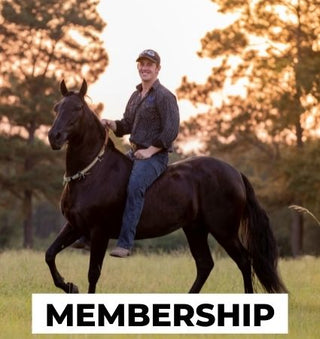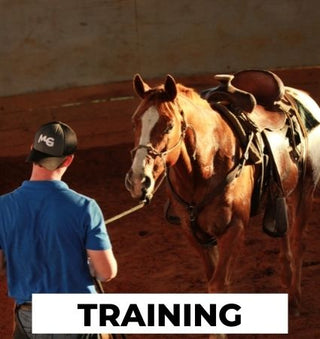Learn how to fix horses that crossfire at the canter!
Watch the Video Here or continue reading below!
What’s going on Team MG! Back by popular demand, we have a video that’s been asked for. What do I do when my horse is crossfiring? For those of you who don’t know what crossfiring is, it’s whenever you’re cantering, and the horse has a different lead in the front than in the back.
Start A Horse Correctly
A lead means simply the foot that is leading in the canter. So, if everything is correct, the front right foot and the back right foot are both leading and they’re hitting at close to the same time. They’re hitting before the foot beside them. Whenever they’re crossfiring, say the front right will be landing first but the back left will be landing first also, and that’s crossfiring. It’s super uncomfortable to ride. The vast majority, I mean the 99th percentile, of it comes from a lack of ease and a lack of body control.
Make sure you’ve gone through the Respect Series. Make sure you’ve gone through taking off the e-brake and getting that horse where he’s willing to move his body wherever we want. He’s soft and easy. We can leg yield him; we can move him around. Basically, we’ve disconnected his head from his body. That’s really going to set you up for success more times than not. It’s going to fix it before you ever really get to the place where you’re trying to fix it.
Get Them Supple To Avoid Crossfiring
What happens so many times when a horse is a young colt like this, he is not set up for success. He catches the wrong lead or he crossfires and it’s just because his hip is not to the inside whenever he’s cantering. He’s not picking up his inside shoulder. He’s just too rigid and stiff through the body and that’s causing for him to be unnatural. Out in the field he’s going to pick up the right lead, if he goes right. He will pick up the left lead, if he goes left. He is going to be on the correct lead. It’s human beings that mess up the correct leads. Really, it’s trying to set him up for success and getting him easy to work with.
Set Them Up For Success
Before I do any of that, I’m just going to ask him to trot off. I would like to see him put his head down. There we go, whenever he pulls on my reins, I squeeze my legs and ask him to come off my rein by grabbing left and then right in my fingertips, and releasing him. I’m going to bring him off the rail to see if I can push his shoulder back over to the rail. I’m going to do that a few times, take my left rein and left leg off and push him over. The reason this is so important for crossfiring horses is because you’re setting them up for success. It might not fix it just right off the bat, but I’m telling you you’re going to have that horse geared so much better to pick up the lead.
Keep Them Bent On A Circle
Notice how I make a smaller circle just so I can push him up here to the right. Then when I ask for the canter, I’m going to ask him in this bend right here. If he has this bend, with his nose to the inside, and his butt to the inside, it’s going to be a lot harder and harder for him to get the wrong lead.
Keep Them Moving Forward
When he’s having a hard time at the trot moving off my leg, coming off the rein, I push him forward. If I touch him with the leg, if I touch him with a spur, he needs to move forward. He’s having an issue, so right there he’s getting a little stuck. When I say stuck, I mean he’s pushing forward into my snaffle and getting stiff. I’m just going to squeeze him forward with my legs and touch left and right until he softens. Then I’m going to release him. I’m going to pick him up again. Whenever I’m picking up the shoulder I’m never crossing over the neck. I want that rein to feel like a solid barrier. If I come over the neck, then it doesn’t feel solid to him anymore. I pick up, pick up, pick up, put my leg on him and release.
Now I’m going to send him towards the rail, going to the left. I’ll pick up the inside left rein, pick up, pick up. I’ll put my left leg and left rein on and the right leg and right rein off, and push him to the right. Let him come off the rail again, left leg, left rein on, right leg right rein off. I’m going to do this until he becomes soft and easy.
I noticed that he’s a lot stiffer on this left side than on the right side. That could be the reason that he has been crossfiring.
Get Them Soft
What I’m going to do is keep this exercise going until he softens up and just melts. Right there he’s grabbing a hold of my left rein and you guys might not even see it, but I can feel the difference. There we go, that was better. I grabbed him a little firmer that time and then the next time that I asked, as soft as I could, he gave as soft as he could. Nice! Let’s come off the rail, shift to my right stirrup, put my left leg left and rein on. Ask with a little encouragement off my leg. There we go.
Aright guys, now we’re going to ask for that canter. Look where his head is nice and low. I would love for it to stay there in the canter. The odds of that happening might not be very good. The end goal, if he can walk here, then he can canter here. He’s off the rail, it’s very important because if he’s off the rail I can leg yield him over. I’m going to pick my inside right hand up and canter to the right.
I want to canter him around whether he gets it right or he gets it wrong doesn’t matter, same exercise. Right here, where he wants to lean into the right, the right leg and right rein bend him, and bring him off the rail. Right rein, right leg moves him to the rail. Let him float in a little when he’s steady. Then put him over here and back to the trot.
Don’t Let Them Get Stiff
A lot of it is him getting stiff when I ask for the canter. When you see him slipping in here, he’s not slipping in the trot it’s only in the canter. This is because he’s leaning in and stiffening up. If he just stays straight, then he won’t have that issue. To get the answer that we want, we have to get him moving under himself. He can’t be under himself while he’s pulling on us. Until he is soft in the bridle it’s going to be hard. When you’re pulling on something, if you’re playing tug of war, you’re leaning against it. We don’t want him leaning against that, we want him carrying himself. Leg yield him over.
Notice how I pick my right hand up every time he tries to lean into the right. Look at how I’m picking his head up, picking his head, and nice buddy! Nice! Those transitions up and down are really going to soften him up. Notice how I picked that inside rein up a little bit. That keeps him from leaning in. Ask for that right lead canter again. Left leg back, oh good boy!
Find The Training Holes
So, just like that, you’ll start seeing where the holes are. You will start seeing the reason that your horse is crossfiring. If your horse is picking up the wrong lead, or if your horse is crossfiring there is something wrong, a fundamental hole that you’re missing. He’s not giving you control of his shoulders; he’s not giving you control of his hips. They get to stiff and rigid. He’s leaning to the inside; he’s kicking his hip to the outside. You want your horse if you’re on the left lead, his hip and his nose should be pointing to the left. If he’s on the right lead his hip and his nose should be pointed to the right. In that exercise right there, we weren’t necessarily trying to fix the crossfire. We were trying to fix this overall guiding and body control.
Letting the crossfire fix itself and that’s so much the case when we’re fixing leads. Fixing crossfire, they’re picking up the wrong leads they only stay on one lead. We’re missing a fundamental hole we’re not able to control their head or their body. From that, the byproduct is the horse is picking up the wrong lead. The horse is slipping in the canter. The horse is cross firing. Instead of focusing on those things, you should focus on the overall brokenness of the horse.
In Conclusion On Crossfiring
You want to get him where he’ll really give up his face when you ask him to move off. He’s trying to come off of that bridle when you have him in a trot or a walk. You’re able to push his shoulders around and push his butt around. He’s able to accept it without getting fussy in the bridle. Everything else is going to melt away on its own. Incorrect leads, they’re going to melt away on their own. Crossfire is going to melt away on its own, and you’re really going to have a seasoned well-broke horse. If you try that let me know how it goes!
Check out more free training resources HERE!









